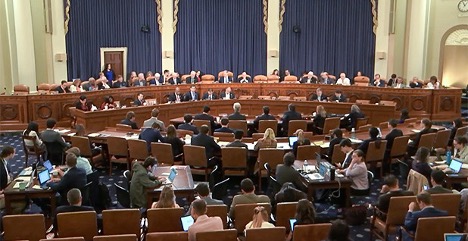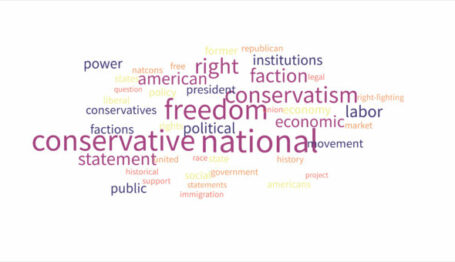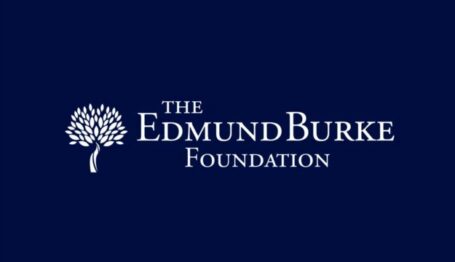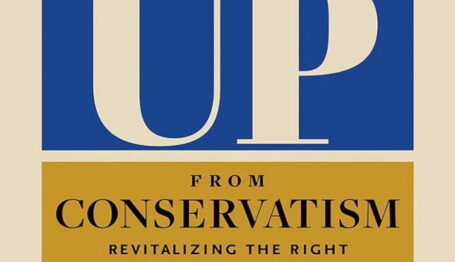Special Report
Understanding and Examining the Political Activities of Tax-Exempt Organizations
Response from Capital Research Center to a request for information from the U.S. House Committee on Ways and Means
 U.S. House of Representatives,
Committee on Ways and Means.
U.S. House of Representatives,
Committee on Ways and Means.

Response from Capital Research Center
to the
U.S. House of Representatives
Committee on Ways and Means
Request for Information on
Understanding and Examining the Political Activities of
Tax-Exempt Organizations under Section 501 of the Internal Revenue Code
Scott Walter
President
Capital Research Center
Capital Research Center, an investigative think tank recognized as a 501(c)(3) tax-exempt entity, has studied the influence of non-profit organizations on the public policy process since its inception in 1984. In particular, CRC has focused on the problems connected to the intersection of politics and tax-exempt entities. We have long hoped for increased attention to and equitable enforcement of activities conducted by charitable non-profit entities that has either the intent or the effect of influencing the outcome of elections and further politicizing the philanthropic sector. The questionable conduct in this area has a long history, and we applaud the Ways and Means Committee’s interest in investigating the questions raised in its Request for Information.
We are honored that the Committee in its Request for Information has made use of a variety of research and public information produced by Capital Research Center and has reinforced arguments we have made on the issues raised by 501(c)(3) voter registration projects and by the massive 501(c)(3) contributions for private funding of government election offices made by Mark Zuckerberg and his wife. Our preliminary comments on select questions from the Committee follow.
Question 3 – exempt organizations whose voter registration activities may have had the effect of favoring a candidate or group of candidates
The Voter Participation Center. The Committee’s Request for Information explains how the Voter Participation Center, a 501(c)(3) charity, has been identified by Mind the Gap, a partisan super PAC, as having a powerful effect on elections favoring Democratic candidates through its targeted voter registration. The Committee also noted that Voter Participation Center in 2019 spent much of its budget on two Democratic-aligned for-profit microtargeting firms. Further evidence of the Voter Participation Center’s illicit partisanship may be found in the book The Victory Lab: The Secret Science of Winning Campaigns, written by liberal reporter Sasha Issenberg and labeled “indispensable” by the Washington Post. The book described the Voter Participation Center (then operating under a different name) thus: “Even though the group was officially nonpartisan, for tax purposes, there was no secret that the goal of all its efforts was to generate new votes for Democrats.”[1]
The Voter Participation Center’s work in elections has drawn criticism from the Washington Post (for confusing voters and not being nonpartisan),[2] from National Public Radio (for allegedly illegal automated calls that seemed aimed to suppress African-American votes for Barack Obama in a primary against Hillary Clinton),[3] and from ProPublica, which published a report headlined, “A Nonprofit With Ties to Democrats Is Sending Out Millions of Ballot Applications. Election Officials [in both parties] Wish It Would Stop.”[4]
The Voter Registration Project. This 501(c)(3) charity, co-located with the for-profit, Democratic- aligned consulting firm Grassroots Solutions, oversaw a secretive, multi-year, $100+ million plan to use 501(c)(3)s and (c)(4)s to turn out millions of Democratic voters in battleground states. The project began in 2015, when a Democratic for-profit consultant sent a draft plan to a Democratic-aligned PAC (EMILY’s List), who forwarded it to Hillary Clinton’s campaign manager, John Podesta. The scheme fermented with help from the president of the 501(c)(3) Wyss Foundation, who also sent Podesta a version of the plan in an email with the subject line, “new (c)(3) version.” That email’s Microsoft Word attachment has tracked changes that revealed how the original, partisan plan, which would only be legal for “hard dollar” entities to execute, had been re-worded slightly into something 501(c)(3) private foundations could fund and 501(c)(3) “charities” could conceivably get away with executing. A sample editing change: an “enormous” difference in “potential political outcomes” (i.e., election victories) in the original version became an enormous difference in “potential voter participation outcomes” in the “new (c)(3) version.”[5]
The project at the center of this campaign, known Everybody Votes, was run through the Voter Registration Project charity. But more importantly (and as the Request for Information demonstrates in Appendix A), Everybody Votes was also at the center of the strategy released by Mind the Gap, a Democratic super PAC co-founded by Barbara Fried (mother of Sam Bankman-Fried, the Democrats’ second-largest donor in the 2022 cycle[6]), to its donors and investors. The Mind the Gap memo outlines the “…single most effective tactic for ensuring Democratic victories—501(c)(3) voter registration focused on underrepresented groups in the electorate.”[7]
The plan was executed, with the help of numerous 501(c)(3)s and (c)(4)s, including the Civic Participation Action Fund, America Votes, States Voices, Center for Popular Democracy,[8] and the Tides Foundation. Especially worth noting are the foundations and donor-advised-fund providers that contributed to the Voter Registration Project’s network of 501(c)(3) organizations and specifically referenced the partisan Mind the Gap memo in their IRS filings; for example, the San Francisco Foundation, the David E. Reese Family Foundation, and the Kelly and Sam Bronfman Family Foundation. For more documentation, see the report by Capital Research Center’s Parker Thayer: “How Charities Secretly Helped Win Elections: Exposing a $120 million ‘nonpartisan’ scheme that helps Democrats win elections.”[9]
Current IRS guidance on 501(c)(3) groups’ involvement in voter registration lacks any example close to the facts and circumstances just described and thus does not contemplate these kinds of sophisticated efforts to sway elections. For example IRS Rev. Rul. 2007-41 gives the quaint example of a charity “setting up a booth at a state fair,” whereas the Mind the Gap strategy memo and the Voter Registration Project plan involve 501(c)(3) private foundations and charities funding and executing voter registration using political operatives’ for-profit firms to microtarget limited demographics only in swing states using sophisticated data-crunching.
Question 4 – changes to IRS Form 990
Some revisions to the annual IRS Form 990/990-PF could provide valuable information that Americans could use to evaluate these organizations.
Improve Grants Reporting. Many nonprofits have similar names, operate under more than one name (for example, an entity “doing business as” another name), are commonly referred to by different variations on their name, or exist as one of a number of nearly identically named (but legally distinct) affiliates or chapters—sometimes sharing the same address. This can cause considerable confusion when attempting to analyze reported grants, because it is not always clear exactly which group is the one that received the grant.
The Form 990 largely addresses this problem by including a column for the recipient’s employer identification number (EIN). This is a unique, nine-digit code that can usually—assuming meticulous accuracy on the part of the filer—be used to unambiguously identify a recipient. The Form 990-PF used by 501(c)(3) private foundations, however, does not include this column. While foundations may sometimes make grants to recipients that do not have an EIN, the IRS should add a column to the Form 990-PF in which to list the grantee’s EIN. In rare occasions when that cannot be listed, an explanation could be provided on the Form.
Another issue with grants reporting involves the use of attachments, rather than listing grants directly in the filing. Occasionally, these attachments are not included with the rest of the Form 990 or 990-PF when it is released to the public.
For example, the Rockefeller Family Fund reported paying out more than $17 million worth of grants on its 2019 Form 990, which is available on the IRS website.[10] The attached Schedule I—which is used to report all grants in excess of $5,000 made to domestic recipients—directs readers to “See Schedule I-1,” but no such schedule is attached to the filing. Anyone wishing to see the Rockefeller Family Fund’s 2019 grantees cannot find this information on its Form 990 as posted by the IRS.
The instructions should either clarify that grants must be listed directly in the prescribed sections of the form or the IRS must ensure that important attachments are, in fact, attached to the copy made available for public disclosure.
Finally, private foundations report grants made to foreign entities on the Form 990-PF in the same manner that they report grants made to domestic entities—including listing the name and address of the foreign recipient. But other nonprofits filing the Form 990, however, are instructed to omit the names of foreign grant recipients on Part II of the applicable Schedule F.[11] They disclose only the purpose of the grant, the amount, and the geographic region.
An IRS background paper detailing 2008 revisions to the Form 990 explained that the idea of reporting identifying information about foreign grantees prompted commenters to raise security concerns about “work in certain unsafe foreign areas.”[12] The IRS should reconsider whether such legitimate concerns are nevertheless outweighed by the significant public interest in foreign-grants reporting—particularly since the Form 990-PF freely discloses this information—or if there are alternative methods of addressing these concerns.
Include Fiscally Sponsored Projects. Fiscal sponsorship presents some unique issues for the Form 990. Briefly, a fiscal sponsorship is an arrangement through which an existing tax-exempt nonprofit sponsors a “project” group that does not have its own tax-exempt status. The sponsor provides administrative services to—and in the case of 501(c)(3) projects, accepts tax-deductible donations on behalf of—the project. Sponsors generally charge a fee for these services.
Grants or contributions made to the project are technically made to the fiscal sponsor, and projects do not file their own Form 990s with the IRS. This greatly limits the public’s ability to obtain information about the project, including its financials, leadership, and more. This can become important when a project achieves national prominence for its activism on controversial sociopolitical issues—as occurred in the case of the Black Lives Matter Global Network Foundation in 2020, for a recent example.[13]
Some have suggested fiscal-sponsorship reforms, including requiring both the sponsoring organization and the project to file separate 990s.[14] Another idea is to simply modify the Form 990 to include a new schedule solely for listing any projects sponsored by the filing nonprofit.[15] That schedule could require basic information about each project—such as its name and address, simplified financials, the identities of executive leadership, the date on which it became a sponsored project, and whether or not the project has applied for its own tax-exempt status.
On the funding side, a simple change to the instructions for both Form 990’s Schedule I and Form 990-PF’s Part XIV could significantly improve transparency regarding grants made to sponsored projects. The IRS should instruct filers who have made a grant to a nonprofit for the purpose of supporting one of that nonprofit’s sponsored projects to clearly indicate the project(s) in the grant description/purpose column of their Form 990 or 990-PF. Some organizations already do this, but the practice should be universal.
Expand Highest-Paid Employee and Contractor Disclosures. In addition to requiring the filing organization to identify certain officers and directors and disclose how much each was paid during the year, both the Form 990 and 990-PF also require a list of the organization’s top five highest-paid employees and highest-paid independent contractors. The threshold for listing both an employee and a contractor is $100,000 on the Form 990 and $50,000 on the Form 990-PF. Though only the top five highest-paid employees and contractors must be specifically named, the filing organization must also report the total number of each who were paid in excess of those thresholds during the year.
Some nonprofits and foundations have numerous highly compensated employees and contractors. The five individuals listed on Stanford University’s 2019 Form 990 were paid amounts ranging from about $2.2 million to $4.5 million that year.[16] The lowest-paid “highest-paid” employee at the Bill and Melinda Gates Foundation in 2019 still made more than $1 million.[17] The New Venture Fund reported paying more than $100,000 to 198 different contractors in 2020, yet it was only required to report the top five (including almost $27 million paid to Arabella Advisors alone).[18]
The sections for listing the highest-paid employees and independent contractors on both the Form 990 and 990-PF should be expanded to allow for more extensive disclosure—perhaps the top 15 or 20 in each category, if applicable. A threshold dollar figure for reporting should still be maintained, and there are arguments that can be made for whether it should be raised or kept at its current level.
While raising the current thresholds could account for inflation, they could perhaps just be kept at current levels, but with more-extensive reporting of contractors who perform smaller-dollar services for a number of different nonprofits, and who are thus influential in the aggregate. The IRS could also consider using different thresholds for employees and independent contractors.
Enforce Foundation Investment Disclosures. Big Philanthropy is exceedingly well-heeled. Of the roughly $1.7 trillion that was parked in American nonprofit endowments at the end of 2017, just over $1 trillion was held by private foundations.[19] Since foundations generally must pay out only 5 percent of their assets for charitable purposes each year, most of their assets are invested. Asset management, accordingly, occupies a central role at many large philanthropies. Yet Form 990-PF does not require meaningful detail on how the vast endowments held by large foundations are invested. This is arguably a form of philanthropic “dark money,” and it also makes it difficult or impossible for the public to evaluate a given foundation’s investments vis-à-vis its own self-imposed standards or the ideological pronouncements of its grantees.
Current IRS instructions require private foundations to attach certain schedules to their Form 990-PFs listing and describing the specific assets in which their endowments are invested. In practice, however, many foundations do not provide meaningful detail on individual holdings. For example, a foundation might simply report a giant lump sum as invested in “corporate stock” or in “global equity funds,” without listing any of the individual corporations or funds in which the money is invested.
The only exception is for government obligations, which the instructions specifically allow to be reported as lump sums based on issuer category (federal or municipal bonds, for example). The IRS should revise its instructions for Part II, Balance Sheets, saying that all other types of investments must be itemized to the extent practicable on the required schedules and noting that lump-sum reporting is unacceptable.[20]
Notes
[1] Sasha Issenberg, The Victory Lab (New York: Crown Publishing, 2013), 305.
[2] Antonio Olivo. “Mail-in ballot applications in Virginia tap into worries about fraud with faulty instructions.” Washington Post. August 6, 2020. https://www.washingtonpost.com/local/virginia-politics/virginia-absentee-ballot-mixup/2020/08/06/5c4029ee-d764-11ea-930e-d88518c57dcc_story.html.
[3] “Group with Clinton Ties Behind Dubious Robocalls.” NPR. 2008. Accessed June 19, 2017. http://www.npr.org/templates/story/story.php?storyId=90114863
[4] Rosenthal, Lauren, Joshua Eaton, and Thy Anh Vo. “A Nonprofit With Ties to Democrats Is Sending Out Millions of Ballot Applications. Election Officials Wish It Would Stop.,” October 23, 2020. https://www.propublica.org/article/a-nonprofit-with-ties-to-democrats-is-sending-out-millions-of-ballot- applications-election-officials-wish-it-would-stop.
[5] See Parker Thayer, “The Left Weaponizes Charitable Cash to Win Political Battles,” Capital Research, October 2021, pp. 13-19, https://capitalresearch.org/publication/capital-research-october-2021/. The Podesta emails were, unfortunately, likely hacked by Russian intelligence agents, but the same is true of the hack of the Bradley Foundation whose contents are used frequently by Sen. Whitehouse and the Center for Media and Democracy.
[6] Steve Mollman, “Oops. Sam Bankman-Fried’s implosion took down Democrats’ second-biggest donor with it as the party gears up to regulate crypto,” Fortune, November 30, 2022; https://fortune.com/2022/11/10/sam-bankman-fried-ftx-joe-biden-democratic-party-second-biggest-donor/.
[7] Mind the Gap, Untitled 2018 Strategy Memo, as described in Theodore Schleifert, “Inside the Secretive Silicon Valley Group that has Funneled over $20 Million to Democrats,” Vox.com, January 6, 2020. https://www.vox.com/recode/2020/1/6/21046631/mind-the-gap-silicon-valley-democratic-donors-stanford. See a reproduction of the memo at “How Charities Secretly Help Win Elections: Exposing a $120 Million ‘Nonpartisan’ Scheme that Helps Democrats Win Elections, Appendix 1.” https://capitalresearch.org/app/uploads/CRC-Voter-Registration-Report.pdf.
[8] CPD is best known for the time one of its leaders, protesting the Brett Kavanaugh nomination, blocked the elevator doors for Sen. Jeff Flake. Elise Viebeck, “Ana Maria Archila reflects on confronting Jeff Flake over Kavanaugh nomination,” Washington Post, September 28, 2018, https://www.washingtonpost.com/politics/i-was-demanding-a-connection-ana-maria-archila-reflects-on-confronting-jeff-flake-over-kavanaugh-nomination/2018/09/28/7593b4fe-c381-11e8-97a5-ab1e46bb3bc7_story.html.
[9] Parker Thayer, “How Charities Secretly Help Win Elections: Exposing a $120 Million ‘Nonpartisan’ Scheme that Helps Democrats Win Elections,” Capital Research Center, August 15, 2023. https://capitalresearch.org/app/uploads/CRC-Voter-Registration-Report.pdf.
[10] Rockefeller Family Fund, IRS Form 990 for Period Ending December 2019, https://apps.irs.gov/pub/epostcard/cor/136257658_201912_990_2021101519102372.pdf. Accessed March 28, 2022. See also https://www.influencewatch.org/non-profit/rockefeller-family-fund/.
[11] Internal Revenue Service, “Instructions for Schedule F (Form 990) (2022),” https://www.irs.gov/instructions/i990sf#en_US_2021_publink51530jd0e555
[12] Internal Revenue Service, “Form 990 Redesign for Tax Year 2008 Background Paper,” December 19, 2007. https://www.irs.gov/pub/irs-tege/background_paper_form__990__redesign.pdf.
[13] See https://www.influencewatch.org/non-profit/black-lives-matter-foundation/.
[14] The Giving Review Editors, “Reform of ‘Fiscal Sponsorships,’” The Giving Review, July 19, 2021. https://www.thegivingreview.com/reform-of-fiscal-sponsorship/.
[15] Hayden Ludwig, “Fiscal Sponsorship, the Left, and Beginning to Explore Reform,” The Giving Review, July 26, 2021. https://www.thegivingreview.com/fiscal-sponsorship-the-left-and-beginning-to-explore-reform/.
[16] Stanford University, IRS Form 990 for Period Ending August 2019, https://apps.irs.gov/pub/epostcard/cor/941156365_201908_990_2020092917336353.pdf.
[17] Bill and Melinda Gates Foundation, IRS Form 990 for Period Ending December 2019, https://apps.irs.gov/pub/epostcard/cor/562618866_201912_990PF_2021061418342101.pdf.
[18] New Venture Fund, IRS Form 990 for Period Ending December 2020, https://www.influencewatch.org/app/uploads/2021/11/new-venture-fund-2020-form-990.pdf. See also https://www.influencewatch.org/for-profit/arabella-advisors/.
[19] Michael E. Hartmann, “How much money is in nonprofit endowments in America?” The Giving Review, July 27, 2020, https://www.thegivingreview.com/how-much-money-is-in-nonprofit-endowments-in-america/.
[20] Internal Revenue Service, “Instructions for Form 990-PF (2022),” https://www.irs.gov/instructions/i990pf#en_US_2021_publink11290yd0e4439.



